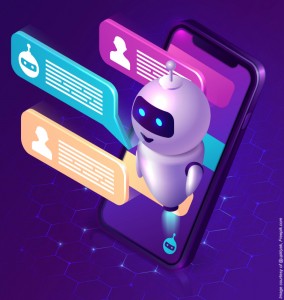Siri, Alexa, Google Assistant…heck, even Domino’s Pizza. Whether you’re ordering your favorite slice, getting your glam on, house hunting, or asking for customer service help, you’re likely interacting with chatbots on a regular basis. No mere novelty, chatbots have emerged as sophisticated, cost-efficient tools that are projected to deliver $11 billion in cost savings for retail, banking, and healthcare by 2023.
But, what about marketing and social media? What role could this technology possibly play in situations where engaging with audiences on a personal level is the Holy Grail? Chatbots not only have a role to play, but may even be the future of marketing. Shocking? Not really, given humanity’s shift to living life online.
Every time there’s another great leap in technology or an emerging trend, the first question we hear is, “How do we get out ahead of this? And how do we use it to benefit our organization?” AI-driven marketing and social media chatbots have only been a thing since 2016 or so, but the increased interest we’re seeing from our own clients tells me that they’re rapidly turning into de facto members of the team. With that in mind, let me offer you a brief primer on chatbots and what they can do for your business…and more importantly, your bottom line.
The ABCs of Chatbots: Automated, Behavioral, Contextual

Why yes, these are the ‘bots you’ve been looking for
Before digging into the myriad of reasons why you should be incorporating them into your marketing and social media mix, we should establish what chatbots – sometimes also referred to virtual assistants – actually are.
An innovative fusion of artificial intelligence (AI) and machine learning, chatbots are automated, software-driven entities that can ask and answer questions without human intervention. As outlined in G2’s Full Guide to Chatbots in 2019, chatbots come in a variety of behavioral flavors. There are rule-based ‘bots that use “if/then” logic, AI versions that rely on Natural Language Processing (NLP) to hold more personalized, contextual conversations, and machine learning types that are dedicated to learning every scrap of info they can about the human they’re chatting with and using that info for their organization’s benefit.
With the ABCs of chatbots out of the way, we can look at the business case for bringing ‘bots onboard.
Here a Bot, There a Bot…
As I mentioned, it’s a safe bet that you’re interacting with chatbots on a regular – if not daily – basis. I find myself interacting with them frequently, particularly when addressing customer service issues.
My ‘net provider uses a chatbot as a troubleshooting pre-screening tool, providing frontline solutions to common problems and escalating queries to a live human as needed. After a recent move, I reached out to my provider’s chatbot to quickly solve a connectivity issue, which was a win-win for both the company and me. I was saved from searching through a lengthy troubleshooting FAQ to find the info I needed; my provider didn’t have to tap a human resource to help resolve my query. It was a positive customer experience that saved me time, and the company money. See? Win-win.
So, back to the question, how and where do chatbots fit into the picture? Social Media Today has excellent data showing that chatbots can be used for lead generation, boosting product launches, gathering data for targeting and analysis, and fostering brand loyalty. That’s positive news for the marketing side of the house, but how about social media marketing? Luckily, social media is also fertile ground for ‘bots.
You’re most likely to encounter chatbots when using Facebook Messenger, given that there are 300,000 or more already deployed on the platform. Why are they so popular? Chalk it up to living in the age of instant gratification. If a brand can’t respond to queries immediately, customers may seek out other brands that can. Deploying ‘bots in the socialverse means brands can increase audience engagement, personalize content delivery, and deliver ‘round-the-clock customer service, among other things. And brands that adopt the technology are reaping the benefits. Take Sephora for example.
A behemoth in the beauty world, Sephora’s chatbots are on fleek. Its virtual assistants provide makeup tips, make product recommendations, offer a virtual try before you buy option, and can even set in-store appointments for busy customers. The brand saw an 11 percent increase in bookings with an average spend of $50 through its ‘bot. That’s pretty decent ROI for an automated system, doncha think?
The cost efficiencies of chatbots are undeniable. They never get tired, cranky, or need bathroom breaks, and can free up human capital to focus on tasks where ‘bots can’t (yet) effectively compete – like understanding and interpreting deeply nuanced conversations picked up through social listening. We haven’t reached the full-on sentient HAL from 2001: A Space Odyssey stage, but with NLP, quantum computing, and other technologies advancing at almost scary speeds, who knows?
Get Your ‘Bot On
By now, you’re probably convinced that chatbots are the Next Big Thing and wondering how to get in on the action. But, I’m guessing that the idea of introducing and mastering a new piece of AI-based automation sounds…well, intimidating. However, integrating chatbots into your marketing and social media mix doesn’t have to be laborious or overwhelming.
There are multiple technology vendors who have chatbot development and deployment down to a science. The right ‘bot for your business depends on multiple factors like cost, the size of your organization, whether you’re looking for an out-of-the-box versus a mostly DIY solution, and where you’ll be installing your ‘bot at. ManyChat; MobileMonkey; Oracle Digital Assistant; Drift; Botsify; Hubspot’s Chatbot Builder; ChatFuel; IBM Watson (yes, that Watson); Flow XO…there are endless options to select from.
Chatbots sound like the coolest thing ever! Go ‘bots, go! Whoa, slow your rollout there, folks. Before your ‘bot frenzy boils over, there are a few things to think about…like how transparency and access to a human is an absolute must. Tricking users into thinking they’re speaking with a live human is a no-go. Users aren’t opposed to speaking to chatbots; in fact, if it saves them time, more than half of consumers would willingly choose a chatbot over human interaction. Saving time is exactly the reason I chose to resolve my connectivity issue via chatbot instead of waiting to talk with a live agent. But, brands have to be up front about employing chatbots.
Other best practices to bear in mind when setting up a chatbot:
- Be sure to give your ‘bot a name and personality because nobody likes interacting with a mindless drone. Chatbots need to be warm, engaging, and relatable, but not obnoxiously funny (unless like Cleo, that’s your brand’s schtick) or over-the-top peppy.
- The human factor is still the most important factor. Tell your users that they’re interacting with a bot and always give them the option to contact a live person during reasonable business hours.
- Be clear and concise. Think carefully about the scripted lines you’re giving your ‘bot. Is the conversation straightforward and easy to understand? Or does the dialog contain too much ambiguity? A/B test your chatbot just like you would a marketing campaign or website redesign to see what resonates.
- Button it up. Adding clickable buttons enables users to dictate choices without having to type them out, thus saving them time and effort.
- Make it clear what your chatbot can and can’t do. If your ‘bot has conversational or functional limits, make sure they’re communicated very clearly to users.
- Don’t neglect collecting your data. I’ve written previously about the importance of using UTM codes for tracking traffic; it’s just as important when your chatbot is sharing product or website links.
With their ability to engage audiences, boost lead generation and qualification, and generate cost savings, chatbots have moved past their humble beginnings and are here to stay. More and more businesses are moving to adopt the technology as part of their marketing and social media mix; now that you’ve read through our chatbots cheat sheet, maybe it’s time for you to follow their lead? Good luck and happy chatting!

